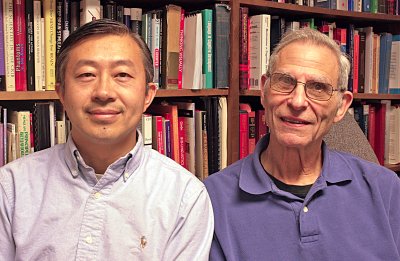EUGENE, Ore. — (June 11, 2012) — Scientists studying the Chinese mindfulness meditation known as integrative body-mind training (IBMT) say they've confirmed and expanded their findings on changes in structural efficiency of white matter in the brain that can be related to positive behavioral changes in subjects practicing the technique regularly for a month. In a paper appearing this week in the online Early Edition of the Proceedings of the National Academy of Sciences, scientists Yi-Yuan Tang and Michael Posner report improved mood changes coincided with increased axonal density — more brain-signaling connections — and an expansion of myelin, the protective fatty tissue that surrounds the axons, in the brain's anterior cingulate region.
In a paper appearing this week in the online Early Edition of the Proceedings of the National Academy of Sciences, scientists Yi-Yuan Tang and Michael Posner report improved mood changes coincided with increased axonal density — more brain-signaling connections — and an expansion of myelin, the protective fatty tissue that surrounds the axons, in the brain's anterior cingulate region.
Deficits in activation of the anterior cingulate cortex have been associated with attention deficit disorder, dementia, depression, schizophrenia and many other disorders.
IBMT was adapted from traditional Chinese medicine in the 1990s in China, where it is practiced by thousands of people. It differs from other forms of meditation because it depends heavily on the inducement of a high degree of awareness and balance of the body, mind and environment. The meditative state is facilitated through training and trainer-group dynamics, harmony and resonance.
In 2010, research led by Tang, a visiting research professor at the University of Oregon, and Michael I. Posner, professor of psychology at the UO, first reported positive structural changes in brain connectivity, based on functional magnetic resonance imaging, that correlated to behavioral regulation. The study was done in the UO's Robert and Beverly Lewis Center for Neuroimaging with 45 participating UO undergraduate students.
The new findings came from additional scrutiny of the 2010 study and another that involved 68 undergraduate students at China's Dalian University of Technology. The researchers revisited data obtained from using an MRI technique known as diffusion tensor imaging. The research team found improved density of the axons involved in brain connections but no change in myelin formation after two weeks. After a month, or about 11 hours of IBMT, both increases in axon density and myelin formation were found as measured by fractional anisotropy, axial diffusivity and radial diffusivity — the important indexes for measuring the integrity of white matter fibers.
"This dynamic pattern of white matter change involving the anterior cingulate cortex, a part of the brain network related to self-regulation, could provide a means for intervention to improve or prevent mental disorders," the authors concluded.
"When we got the results, we all got very excited because all of the other training exercises, like working-memory training or computer-based training, only have been shown to change myelination," Tang said. "We believe these changes may be reflective of the time of training involved in IBMT. We found a different pattern of neural plasticity induced by the training."
"This study gives us a much more detailed picture of what it is that is actually changing," Posner said. "We did confirm the exact locations of the white-matter changes that we had found previously. And now we show that both myelination and axon density are improving. The order of changes we found may be similar to changes found during brain development in early childhood, allowing a new way to reveal how such changes might influence emotional and cognitive development."
The improved mood changes noted in this and earlier studies are based on self-ratings of subjects based on a standard six-dimensional mood-state measure, said Tang, who is now the director of Texas Tech University's Neuroimaging Institute and holder of the Presidential Endowed Chair in Neuroscience in TTU's psychology department.
Tang and Posner first reported findings related to IBMT in 2007, also in PNAS. They found that doing IBMT for five days prior to a mental math test led to low levels of the stress hormone cortisol among Chinese students. The experimental group also showed lower levels of anxiety, depression, anger and fatigue than students in a relaxation control group.
In 2009 in PNAS, Tang and his Chinese colleagues, with assistance from Posner and UO psychology professor Mary K. Rothbart, found that IBMT subjects in China had increased blood flow in the right anterior cingulate cortex after receiving training for 20 minutes a day over five days. Compared with the relaxation group, IBMT subjects also had lower heart rates and skin conductance responses, increased belly breathing amplitude and decreased chest respiration rates.
China's National Basic Research Program, the U.S. Office of Naval Research and the Intramural Research Program of the National Institute on Drug Abuse of the National Institutes of Health (R21DA030066) supported the new research. Co-authors with Tang and Posner were Qilin Lu of Dalian University of Technology, Ming Fang of the Institute of Basic Medical Sciences in Beijing, China, and Yihong Yang of the National Institute on Drug Abuse in Baltimore, Md.
About the University of Oregon
The University of Oregon is among the 108 institutions chosen from 4,633 U.S. universities for top-tier designation of "Very High Research Activity" in the 2010 Carnegie Classification of Institutions of Higher Education. The UO also is one of two Pacific Northwest members of the Association of American Universities.
Media Contact: Jim Barlow, director of science and research communications, 541-346-3481, jebarlow@uoregon.edu
UO Science on Facebook: http://www.facebook.com/UniversityOfOregonScience
Note: The University of Oregon is equipped with an on-campus television studio with satellite uplink capacity, and a radio studio with an ISDN phone line for broadcast-quality radio interviews. Call the Media Contact above to begin the process.
###
Media Relations